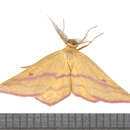Conservation Status
provided by University of Alberta Museums
Not of concern.
- license
- cc-by-nc
- copyright
- University of Alberta Museums
Cyclicity
provided by University of Alberta Museums
Alberta flight dates range from mid July to late August.
- license
- cc-by-nc
- copyright
- University of Alberta Museums
Distribution
provided by University of Alberta Museums
Quebec west to southeastern Alberta, with a single record from Ft. Smith, NWT (McGuffin 1967).
- license
- cc-by-nc
- copyright
- University of Alberta Museums
General Description
provided by University of Alberta Museums
The tan forewings and ochre hindwings, with two broad pink transverse bands and border, are unmistakable. The male antennae with its very long pectinations add to the uniqueness of this elegant moth.
- license
- cc-by-nc
- copyright
- University of Alberta Museums
Habitat
provided by University of Alberta Museums
Prairie grasslands and shrublands.
- license
- cc-by-nc
- copyright
- University of Alberta Museums
Life Cycle
provided by University of Alberta Museums
The egg hatches in about seven days, and larvae go through five instars and mature in 28 to 30 days. The pupa is light yellow-green and light brown with a purplish dorsal line (McGuffin 1967). Adults come to light. There may be two flights annually in the southern prairies.
- license
- cc-by-nc
- copyright
- University of Alberta Museums
Trophic Strategy
provided by University of Alberta Museums
Larvae feed on muse-ear chickweed (Cerastium), chickweed (Stellaria) and several species of knotweed (Polygonum) (Handfield 1999).
- license
- cc-by-nc
- copyright
- University of Alberta Museums
Haematopis grataria
provided by wikipedia EN
Haematopis is a monotypic moth genus in the family Geometridae erected by Jacob Hübner in 1823. Its only species, Haematopis grataria, the chickweed geometer, was first described by Johan Christian Fabricius in 1823.[1] It is found throughout the United States. In Canada it is found from Quebec to Alberta, north to the Northwest Territories.
The wingspan is 20–25 mm (About 3/4-1 in). Adults are on wing from May to October. It is a day-flying species.
The larvae feed on various low-growing plants, including Stellaria, Polygonum and clover.
Description
Adults of this species rest with their wings held out flat and to their sides. Their wings are a pale yellow, and their forewings each have a small red or pink spot in the center. Both the forewings and the hindwings each have two pink or red bands, which appear to be continuous across both sets of wings when the moth is in its resting position. Male chickweed geometers have feathered antennae, while females have thinner, thread-like antennae. [2]
References

- license
- cc-by-sa-3.0
- copyright
- Wikipedia authors and editors
Haematopis grataria: Brief Summary
provided by wikipedia EN
Haematopis is a monotypic moth genus in the family Geometridae erected by Jacob Hübner in 1823. Its only species, Haematopis grataria, the chickweed geometer, was first described by Johan Christian Fabricius in 1823. It is found throughout the United States. In Canada it is found from Quebec to Alberta, north to the Northwest Territories.
The wingspan is 20–25 mm (About 3/4-1 in). Adults are on wing from May to October. It is a day-flying species.
The larvae feed on various low-growing plants, including Stellaria, Polygonum and clover.
- license
- cc-by-sa-3.0
- copyright
- Wikipedia authors and editors

